Diffusion Theory: Extensions and Adaptations
There is a long history of trying to understand the spread of ideas and innovations within a population or society. The basic notion of diffusion theory is that a new idea is adopted very slowly during the early stages of its diffusion process. Then, if the innovation is perceived as relatively advantageous by its initial users, its rate of adoption takes off as early adopters share their favorable experiences with their peers.
The theory of diffusion of innovations originated in the first half of the 20th century and was later popularized by American sociologist Everett M. Rogers in his book Diffusion of Innovations, first published in 1962.
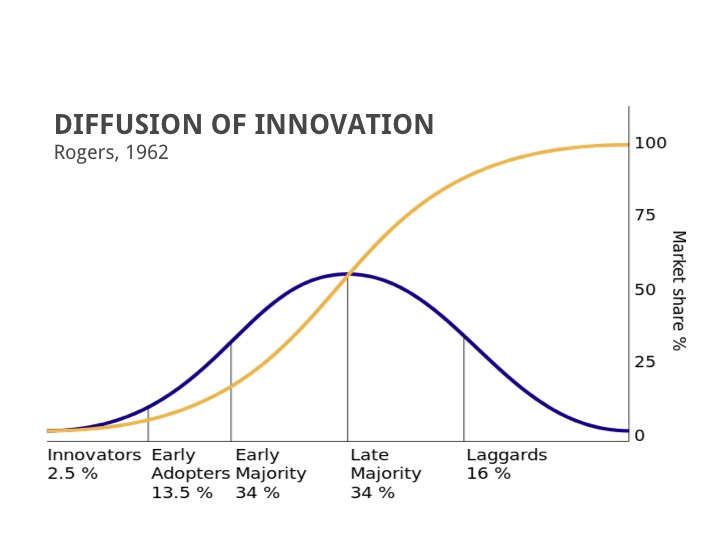
Diffusion theory developed through an interest in social transformation and through explorations of the consequences of the development, spread, and adoption or rejection of new products, activities, and ideas. For example, anthropologists studied the introduction of the horse within and among indigenous populations of North America, the spread and modification of dance ceremonies among Native American groups, and the spread of corn (maize) cultivation from America to Europe.
Early sociological studies included the examination of social and legal trends, such as the influence of a city on surrounding areas, the diffusion of governing practices, and the use and consequences of technology. Rural sociologists focused on the spread of new ideas among farmers and subsequent changes in agricultural practices.
Diffusion of Diffusion Theory
Diffusion of Innovations and Rogers’ later books are among the most often cited in diffusion research. His methodologies are closely followed in recent diffusion research, even as the field has expanded into, and been influenced by, other methodological disciplines.
Diffusion of Innovations has spawned a range of adaptations that extend the concept or apply it to specific domains of interest. The following models and frameworks are extensions of diffusion theory that build upon the foundational concepts created by Everett Rogers:
Tipping Point
Key to diffusion theory is the notion of critical mass, or “tipping point” after which, ultimately, the total diffusion of an innovation is likely. The tipping point is the inflection point between the early and late majority in the bell-shaped curve of adoption.
Everett Rogers coined the term tipping point (along with early adopter) in 1962 as part of his book entitled Diffusion of Innovations.
Most researchers place the tipping point between 10-25 percent depending upon the innovation. This means, on Rogers’ Diffusion Curve, that you need between 7 percent of the early adopters and 9 percent of the early majority to accept an idea before it spreads to the entire population.
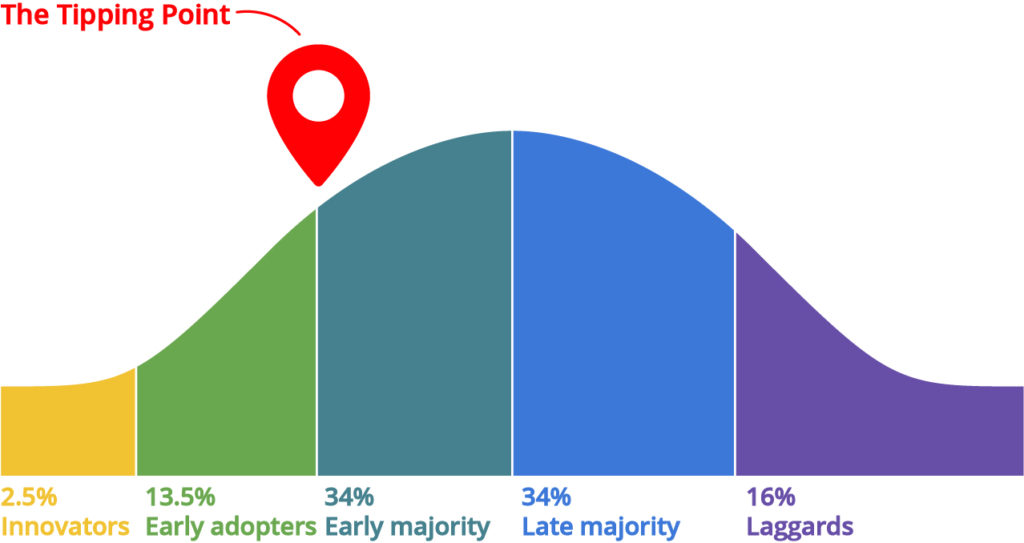
Tipping points essentially refer to thresholds—the point in time during change at which the forces of innovation pushing for some new state outweigh the traditional forces working to maintain the status quo. In sociology, a tipping point is a point in time when a group—or many group members—rapidly and dramatically changes its behavior by widely adopting a previously rare practice
It is the critical point in a situation, process, or system beyond which a significant and often unstoppable effect or change takes place
Technology Adoption Lifecycle
Everett Rogers’ research and subsequent development of diffusion theory was based on studying farmers and their willingness to adopt a new type of hybrid corn seed. The Technology Adoption Lifecycle is an adaptation that attempts to translate the characteristics of farmers, into descriptions of people who might adopt new technologies.
Like Diffusion of Innovations, the underlying thesis of the Technology Adoption Lifecycle is that innovations are absorbed into any given user base in stages corresponding to psychological and social profiles of segments within that user community. The process can be represented by a bell curve with definable stages; each associated with a definable group, and each group making up a predictable portion of the whole community.
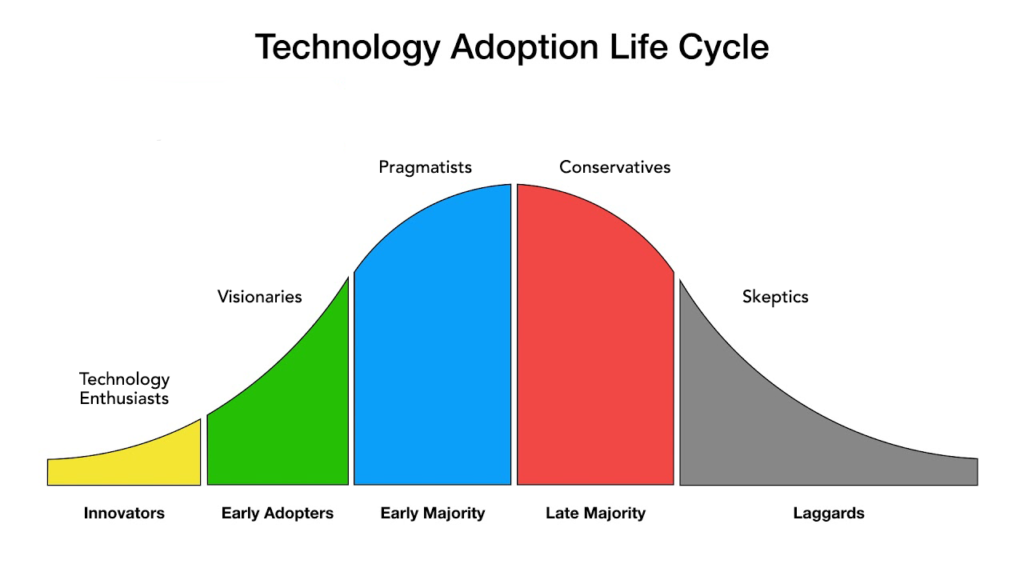
The psychographics of each group in the adoption process influences the development and dynamics of the market. The description of each adopter group remained essentially the same, but the group labels were changed:
- Innovators became technology enthusiasts
- Early Adopters became visionaries
- The Early Majority became pragmatists
- The Late Majority became conservatives
- Laggards became skeptics
The Innovator’s Dilemma
The Innovator’s Dilemma has been heavily criticized by leading professors at Harvard and other business luminaries. It is a model of innovation management that begins by defining two categories of technologies — sustaining and disrupting. Sustaining technologies improve product performance or improve an established product. Disruptive technologies are supposedly innovations that result in worse product performance especially in the near term.
The Innovator’s Dilemma identifies the difficulties that large companies have in dealing with disruptive innovation. Traditional business practices, such as strategic planning and paying close attention to customer needs, fail when confronting disruptive innovations in the market. Business managers must be prepared for this paradox by using a theoretical framework for managing its impact on established firms.
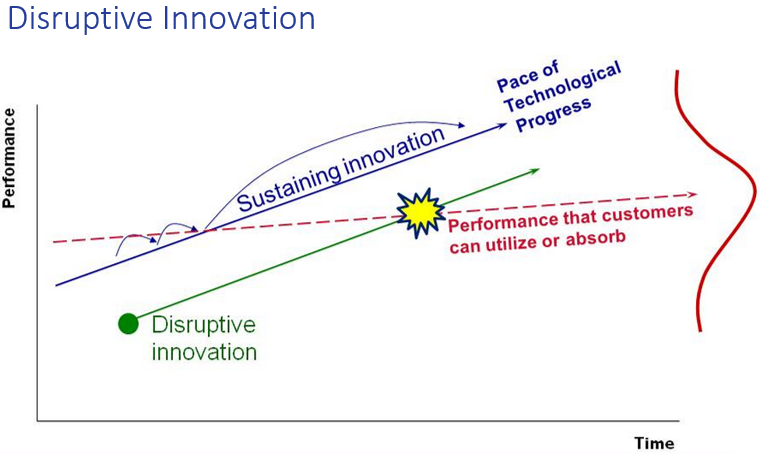
Innovator’s Dilemma uses the bell curve established as part of diffusion theory to demonstrate the range of performance that can be extracted from a new innovation by different adopter groups.
Chasm Diffusion Theory
Chasm Theory is a third-order adaptation of Diffusion Theory, which seeks to explain how, why, and at what rate new technologies are accepted by a group or population. The underlying thesis of both models is that innovations are absorbed into any given user base in stages corresponding to psychological and social profiles of segments within that user community.
The creators of the chasm concept hypothesized that instead of a continuous transition between adopter groups, there is actually a gap or chasm in the adoption sequence.
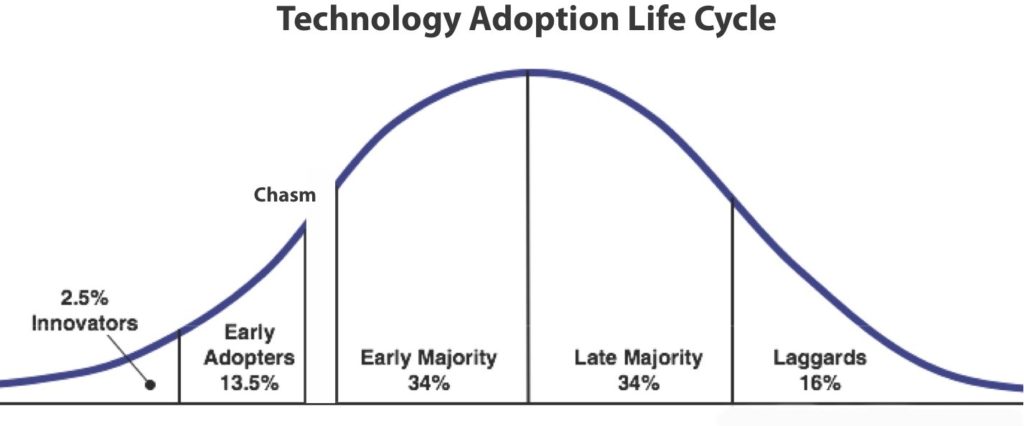
This theory was developed specifically for new high-tech products, and it highlights the fact that high-tech products don’t follow the same pattern of adoption as other non-technical products. Chasm theory says high tech products often struggle to gain mainstream acceptance, and even fail, even though they are initially well received.
The theory identifies the point of greatest difficulty in the development of a high-tech market as a transition from an early market, dominated by early adopters to a mainstream market dominated by a large group of customers who are realistic and practical. Initially this theory was labelled “the marketing chasm,” and the framework was used exclusively by management consultants in the Pacific Northwest.
Confusion and Misuse
During the last thirty years, innovation has evolved as the synonym for the development of nations, the key to human progress and the sole driver of business success. Innovation nowadays is not simply the “creation of something new” but also a panacea for the solution to a broad range of problems. And the term “innovation” is more and more often used – by policymakers, marketing specialists, advertising specialists and management consultants – not as a strict scientific concept but as a metaphor, political promise, slogan or a buzzword.
Address
- Research Ext. Golden Gate University
- 560-584 Mission Street
- San Francisco, California 94105
Information
- Call: +1 (415) 418-7630
- Email: [email protected]
